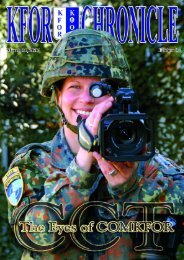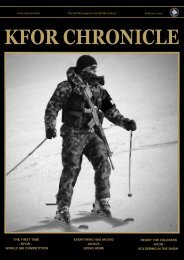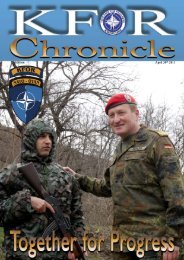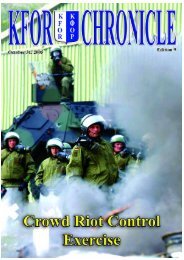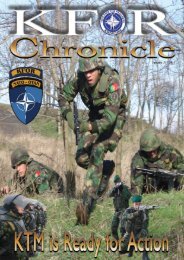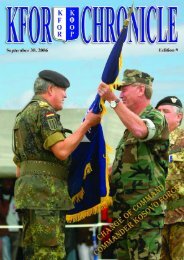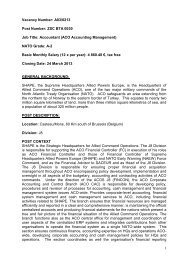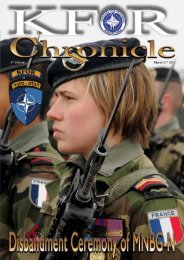2009-08_Kfor Chronicle_4:Layout 1.qxd - ACO - Nato
2009-08_Kfor Chronicle_4:Layout 1.qxd - ACO - Nato
2009-08_Kfor Chronicle_4:Layout 1.qxd - ACO - Nato
- No tags were found...
Create successful ePaper yourself
Turn your PDF publications into a flip-book with our unique Google optimized e-Paper software.
One year of Unity of Effort!It is time to handover the command of the KosovoForce to Lt. Gen. Markus Bentler. After oneintensive and challenging year, I think we haveprogressed with our mission towards the endstate. I want just to mention some key points thathave marked our way during my command. Fromthe operational perspective, KFOR has finallysynchronized all the activities and the EffectsBased Approach to Operations has provided, interalia, a very useful tool to assess the situation.This has led KFOR on the way to the followingphase, the Deterrent Presence. Talking about thenon-kinetic approach, the introduction of theKosovo Development Zones' Concept hasbrought KFOR, the Institution in Kosovo and theInternational Community to a better coordinationand cooperation. Eventually, the New Tasks assigned to KFOR have been dealt with highprofessionalism and competence. We have successfully stood down the Kosovo Protection Corpsand we are standing up the Kosovo Security Force (KSF). The latter has already achieved theInitial Operational Capability (IOC). This is giving to KSF the necessary boost for the future. Iam leaving Kosovo with a bittersweet feeling: the joy for the great achievements, the displeasurefor leaving Kosovo and my Kosovar Friends together with all the International CommunityRepresentatives and KFOR's Soldiers.I would like to thank you all and to wish you all the best for a brighter future.Giuseppe E. GayLieutenant GeneralItalian ArmyKFOR XIII Commander2KFOR <strong>Chronicle</strong>, August, <strong>2009</strong>
"To everything there is a season and atime to every purpose under the heaven."It is the season and the time for me to say farewell toyou, the wonderful readers of the KFOR <strong>Chronicle</strong>.It is time for this captain to sail off (in the words ofa sailor, my excellent Deputy, Andre Sabzog) to newhorizons. I have been here for about six months andconsider myself privileged to have been part of themilitary life here in Kosovo. I have been especiallyhonored to work as the Chief of the Public AffairsOffice team. You have been given one of the mostchallenging and exciting tasks, "to uphold the imageof KFOR," and you have consistently fulfilled withsacrifice and professional excellence. You have alsocarried out your duties in a manner that reflects wellupon your countries. Your Nations could ask nomore. I would also like to introduce you to the next captain of this ship, Colonel Manfred Wittig. I know thathe will bring fresh energy and enthusiasm to the Branch. My work would not have been as joyful or successfulwithout the support and collaboration of all the Flag Officers, especially the JEC Chief and his Team, withwhom we have worked so closely. Last, but not least, I wish to thank the "J heads" inside KFOR HQ and all thePAOs of the MNTFs. We had a great time and I wish you a successful and peaceful continuation of your tourin KFOR and a safe trip back home.All the best and take care,Stefano SchiappacasseColonel Italian ArmyChief Public Affair OfficeCommander KFORLt. Gen. Giuseppe E. Gay, ITA ArmyChief Public Affairs OfficeCol. Stefano Schiappacasse, ITA ArmyChief Internal Infomation & EditorMaj. Andreas Brückner, AUT ArmyJournalistLt. Col. Vadym Tymoshenko, UKR Ar myWebmasterOR-7 Rholondra Louis, U.S. Air ForcePhotographer and DesignMr. Afrim HajrullahuE-mail & web:kforchonicle@hq.kfor.nato.intwww.nato.int/kforThe KFOR <strong>Chronicle</strong>is produced and fully fundedby HQ KFOR.It is published for KFOR forcesin the area of responsibility.The contents are not necessarilythe official views of, or endorsed by,the coalition governments’defense departments.Editorial content is edited,prepared and provided by theInternal Information Sectionof HQ KFOR’s Public Affairs Office(PAO) in Pristina, Kosovo.PAO HQ KFORreserves the right to edit content toconform to style and space requirements.Articles run on a space-available basis.The KFOR <strong>Chronicle</strong> isprinted by RASTERTel: 038 601 606ations within KFOR:BelgiumBulgariaCanadaCroatiaCzechRepublicDenmarkEstoniaFranceGermanyGreeceHungaryItalyLatviaon-ATOationsArmeniaAustriaFinlandIrelandMoroccoSwedenSwitzerlandUkraineATO ationsLuxembourgNetherlands NorwayPolandPortugalRomaniaSlovakiaSloveniaSpainTurkeyUnited KingdomUnited StatesKFORStructureHQ KFORMNTF CentreMNTF NorthMNTF WestMNTF SouthMNTF EastKTMMSUHSGCOMMZ(S)KFOR <strong>Chronicle</strong>, August, <strong>2009</strong> 3
July 29, <strong>2009</strong>The new Supreme Allied Commander of Europe(SACEUR), Admiral James Stavridis, United StatesNavy, visited Kosovo with a delegation. They metwith COMKFOR, Lieutenant General GiuseppeE. Gay, to have an update on the security situation inKosovo and KFOR. It was Admiral James Stavridis'first visit to Kosovo since succeeding General JohnCraddock.August 01, <strong>2009</strong>Kosovo Force Commander, Lieutenant GeneralGiuseppe E. Gay, hosted a Swiss delegation headedby Mrs. Karin Keller-Sutter, Swiss Senior ExecutiveRepresentative and Head of the Department ofJustice and Police. During her visit, Mrs. Keller-Sutter; Chief Swiss Armed Forces Joint Staff, MajorGeneral Peter Stutz; and Swiss Ambassador,H.E. Lukas Beglinger, discussed the current situationin Kosovo and KFOR.August 06, <strong>2009</strong>August 06, <strong>2009</strong>Kosovo Force Commander, Lieutenant GeneralGiuseppe E. Gay, greeted Hungarian delegationheaded by Mrs. Agnes Vadai, Senior State Secretaryand second in charge, Hungarian Ministry ofDefense. During her courtesy visit, Mrs. Agnes Vadaidiscussed the current situation in Kosovo and KFOR.4KFOR <strong>Chronicle</strong>, August, <strong>2009</strong>
August 13, <strong>2009</strong>The new NATO Secretary General, Mr. Anders FoghRasmussen, visited Kosovo for the first time. Afterarrival, NATO Secretary General, together withKosovo Force Commander, Lieutenant GeneralGiuseppe E. Gay, moved to KFOR Headquarters,where an office call with COMKFOR and situationalupdate took place.NATO Secretary General expressed sincere thanks toCOMKFOR for his hard work during the last year.August 19, <strong>2009</strong>Commander KFOR, Lieutenant General GiuseppeE. Gay, hosted Czech Prime Minister, Mr. Jan Fischerduring his one-day visit to Kosovo together withCzech Minister of Defense, Mr. Martin Bartak. Themain discussions during the Office Call were thefuture of Kosovo Forces, evolving to "DeterrentPresence," cooperation with Kosovo Police Serviceand local capability building.August 26, <strong>2009</strong>August 26, <strong>2009</strong>Kosovo Force Commander, Lieutenant GeneralGiuseppe E. Gay greeted Mr. Christopher Dell, newU.S. Ambassador to Kosovo. It was the first visitof Mr. Dell to KFOR Headquarters after hisappointment. Mr. Dell discussed with COMKFORthe current situation in Kosovo.KFOR <strong>Chronicle</strong>, August, <strong>2009</strong> 5
Story and photos byKFOR <strong>Chronicle</strong> TeamOn 13 August <strong>2009</strong>, the new NATOSecretary General, Mr. Anders FoghRasmussen, with delegation, visitedKosovo for the first time. TheSecretary General's visit was full ofevents and meetings.After arrival to Slatina militaryairport, NATO Secretary General,together with Kosovo ForceCommander Lieutenant GeneralGiuseppe E. Gay, moved byhelicopter to KFOR Headquarters, where an office callwith COMKFOR and situational update took place.During the joint meeting in Pristina with President Mr.Fatmir Sejdiu and Prime Minister Hashim Thaci, Mr.Anders Fogh Rasmussen expressed his satisfaction withthe progress that was made in the last ten years inKosovo. NATO Secretary General reassured the leadersof Institutions in Kosovo that Kosovo remained one ofthe priorities of the Alliance. Mr. Rasmussen added thatfor the Balkans, as indeed for the Euro-Atlanticcommunity more broadly, he was fully committed to theprinciple of NATO's Open Door. Membership is not aright - countries must be ready. However, NATOenlargement has already demonstrated its power tospread stability and promote reform. NATO SecretaryGeneral expects that this will continue during his tenure.Later, NATO Secretary General and COMKFOR spokewith Mr. Fehmi Mujota, Ministry of Kosovo SecurityForce (KSF) and KSF Commander Lieutenant GeneralSulejman Selimi on issues relating to NATO support ofKSF activities. One of the last meetings with localrepresentatives was briefed with Chairman of SerbIndependent Liberal Party (SLS) Slobodan Petrovic.After, Mr. Rasmussen moved to Multinational TaskForce North (MNTF-N) Headquarters in CampMaréchal de Lattre de Tassigny, where he had meetingswith MNTF-N Commander Brigadier General PatrickRibayrol and local authorities, and visited the camptroops. NATO Secretary General also participated in ahelicopter flight over the area of responsibility inMNTF-N, the northern part of Kosovo.At the end of his visit, the NATO Secretary Generalgave a press conference in the Slatina Military Airport for media representatives. Having answered the journalist'squestions, Mr. Rasmussen spoke about future KFOR reduction of troops in the context of improved security situationin Kosovo and NATO readiness to support Kosovo in the future.The NATO Secretary General expressed sincere thanks to COMKFOR for his hard work during the last year.6KFOR <strong>Chronicle</strong>, August, <strong>2009</strong>
KFOR <strong>Chronicle</strong>, August, <strong>2009</strong> 7
Story by Spc. (OR-4) Darriel Swatts, 69th Public Affairs Detachment, US ArmyCAMP BONDSTEEL, Kosovo - Croatia, nestled between the Adriatic Sea and Serbia, became part of theNATO-sponsored KFOR mission for the first time on July 2, <strong>2009</strong>."This is our first time being part of the KFOR mission," said Major (OF-3) Michael Krizanec, NationalContingent Commander, Senior National Representative and pilot for the Multi-Role Helicopter Squadron,Croatian Air Force. "It is also the first time the Croatian Air Force has deployed to a NATO mission."The Croatians are stationed at Camp Bondsteel in Multinational Task Force-East (MNTF-E); however, they arenot part of that task force, they are part of KFOR Main.8KFOR <strong>Chronicle</strong>, August, <strong>2009</strong>
"When we arrived here at Bondsteel we did mandatory, in theater training like area orientation flights with [theAlaska National Guard] Task Force Arctic Eagle," said Krizanec. "It goes to show the brotherhood that isbetween pilots extends across nations and we are here to help each other."Some of the training they did prior to arriving at Camp Bondsteel included air insertion and extraction, medicalevacuation, sling load, fire fighting and general transportation."We trained with the U.S. prior to coming here," said Master Sgt. Denis Burangi, crew chief for the Mi-171 HipMulti-Role helicopter, Croatian Air Force. "We trained with the U.S. Navy personnel, Air Force pilots, andArmy Special Forces prior to coming here to KFOR."Due to the size of their aircraft, 69 feet 10 inches rotor diameter with the weight of 15,700 pounds and a lengthof 60 feet 5 inches, and the amount of deployed personnel, they could not be stationed at any other base exceptCamp Bondsteel. The Mi-171 is a Russian built helicopter that can sling load up to four tons of equipment orcarry up to 24 fully equipped soldiers."I would like to express my gratitude to the U.S. Army, who was willing and able to take usin to Camp Bondsteel," said Krizanec. "The bottom line is that if it weren't for the U.S. Army andBondsteel, our deployment wouldbe almost impossible. They are theonly base in KFOR that could takeus in."Now that they have found a base tocall home for the remainder of their three-monthrotation and have been trained in the area flightpatterns, theycontinue to fly theirway into the historybooks, doingwhatever missioncomes their way,following theirunit's motto 'Youask, We deliver'.KFOR <strong>Chronicle</strong>, August, <strong>2009</strong> 9
Story by OF-4 Carlos Lapresta, Spanish Army and KFOR <strong>Chronicle</strong> TeamPhotos by KFOR <strong>Chronicle</strong> TeamOn the 31st of July, at 1230hrs, under the leadership of Brigadier General Roberto Perretti, Multinational TaskForce West (MNTF-W) Commander, and Colonel (OF-5) Ricardo Serrano Cueto, Senior of the SpanishContingent in Kosovo, a military parade took place at Camp España`s Cervantes Square in Istog/Istok. Theceremonies were aimed at marking the Transfer of Authority from KSPAGT XXIII "Castilla y León" and theSpanish Redeployment Support Unit (KSPUAR, in its Spanish acronym) and end of operational activities forthe Spanish KFOR troops.Different KFOR military and civilian authorities from the local municipality, and a number of civilianrepresentatives from the various ethnic groups attended the festive event. The function started fromceremonial formation of Spanish troops at the marching pad of the camp. During the ceremony BrigadierGeneral Perretti awarded the Non-article 5 NATO Medal to OF-5 Javier García Blázquez, Commander of thetransferred KSPAGT XXIII.After presentation, OF-5 García Blázquez addressed the attendees in both English and Spanish with a speechin which he thanked local authorities and representatives from the ethnic groups for their help andcooperation. He also dedicated words of gratitude to General Perretti, for his committed support at all times.In his speech, he highlighted the indefatigable work done by KSPAGT XXIII. He encouraged the KSPUARmembers to follow the same path and to keep the same concentration in order to give the farewell to thismission in September with the inner pride of leaving behind a well-performed duty.10KFOR <strong>Chronicle</strong>, August, <strong>2009</strong>
During Brigadier General Perretti speech, he thanked the Spanish for their dedication and great performancein their relations with the locals, also pointing out the high military values proven by the Spanish soldiers.He stressed that Spain could well be proud of its soldiers. Finally, he emphasized the loyalty and fullcommitment shown by OF-5 García Blázquez, closing his speech with a warm dedication to all those whodied in the course of duty serving in this land for the past ten years of mission.Then two Spanish soldiers accompanied by standard-bearers laid a wreath at the commemorative obelisk toall Spanish soldiers, who gave their lives during mission in Kosovo. For a while, the solemn melody playedto show respect while all flags were lowered slowly and reholstered. The ceremony concluded with a paradeby the Spanish KFOR sub-units and tactical vehicles, which left a great impression on attendees. Spanishsoldier demonstrated excellent skills in marching and driving tactical vehicles during parade.KSPAGT XXIII "Castilla y León" has scoured 253.716 kilometres, conducted 3030 patrols in vehicle and2131 on foot, combining this duty with the laborious logistic redeployment tasks.After the parade, Spanish Redeployment Support started its work to disassemble all equipment in the campand prepare it for redeployment to Spain in accordance with Spanish Government's decision to withdraw itstroops from Kosovo. Spanish peacekeepers in Kosovo are undertaking now all necessary measures toconclude their mission by September and in this respect, the Spanish base in Dubrave/Dubrava Istog/Istokmunicipality was returned to the local municipality. The official ceremony was held on 17 August <strong>2009</strong>, atthe base Camp Espana in the presence of representatives of Spanish contingent and municipality. Speakingat the ceremony, OF-5 Javier García Blázquez said that he hoped this occasion will be a symbol of Spain'spresence and solidarity with Kosovo's people.The Spanish KFOR future withdrawal after a 10-year presence is a sign of irreversible changes that have takenplace, sufficient improvement of stability, and a safe and secure environment in Kosovo. Spanish troops mayleave Kosovo, but the memories about the good deeds of the Spanish will live in the souls of local inhabitantsfor long years.KFOR <strong>Chronicle</strong>, August, <strong>2009</strong> 11
Story by OR-3 evada Smith, US Army and KFOR <strong>Chronicle</strong> TeamPhotos by KFOR <strong>Chronicle</strong> TeamMultinational Task Force East (MNTF-E) assumed responsibility of the Stimlje/Shtime municipality fromMultinational Task Force Center (MNTF-C), 15 August <strong>2009</strong> during a Transfer of Authority ceremony. Theevent was attended by MNTF-C Commander, MNTF-E Deputy Commander, and Latvian Ambassador toSlovenia, Mr. Juris Poikans, Latvian National Guard Commander OF-5 Juris Zeibarts, Major ofStimlje/Shtime municipality and representatives of KFOR contingents within two MNTFs.The transfer took place to facilitate coordination with the Kosovo Police (KP) on a regional level sinceStimlje is part of the Ferizaj Kosovo Police Regional Command and judicial region in MNTF-E area ofoperation. "Until now Stimlje/Shtime has been the only municipality not covered by the same KPRegional Command and Multinational Task Force," said OF-5 Tom Loomis, MNTF-E DeputyCommander - Manuever. There has been a detailed transfer process in order to achieve a successful handover,which has involved both Task Forces and the key leaders of the municipality and regional Kosovo Police.The Irish troops and Latvian Liaison Monitoring Team (LMT) handed over the responsibility inStimlje/Shtime region. Task Force Hellas, one of the four ground maneuver battalions of MNTF-E assumed12KFOR <strong>Chronicle</strong>, August, <strong>2009</strong>
primary KFOR responsibility for the area comprising the Stimlje municipality. Soldiers from TF Hellas, aswell as MNTF-E LMT troops have been conducting joint operations with the MNTF-C elements through Julyto ensure the transition between KFOR Task Forces is seamless to the population.In his speech, the Latvian National Guard Commander, OF-5 Juris Zeibarts thanked all representatives ofmilitary contingents for mutual beneficial cooperation with Latvian KFOR for Kosovo future. He told Latviancontingent's tour in Kosovo after 10 years and 7 months commitment to KFOR and to all people in Kosovowas going to the end now and expressed the expectation to see NATO colleagues again in Afghanistan.The ceremonial of Latvian flag's lowering, which marked the end of activities for the Latvian KFOR, tookplace under the leadership of Brigadier General Seppo Toivonen, as MNTF-C Commander, in Camp Ville,Lipjan on 15 August <strong>2009</strong>. Latvians already left Kosovo, but they have fulfilled their tasks with dignity andin a highly professional manner to the last moment of their service in KFOR."The security situation in Kosovo has improved a lot. Today KFOR can be seen as the third line respondentand the last guarantee of a safe and secure environment as well as freedom of movement in the area", saidBrigadier General Seppo Toivonen, the MNTF-C Commander, during the ceremony.At this moment, soldiers of Multinational Task Force East have successfully performed their mission inStimlje/Shtime municipality for one month after replacing their predecessors.KFOR <strong>Chronicle</strong>, August, <strong>2009</strong> 13
Story and Photos by KFOR <strong>Chronicle</strong> TeamAugust is full of important commemorative dates for Ukrainians,including the greatest national holidays - Independence Day, andNational Flag Day. On 23 August <strong>2009</strong>, a group of enthusiastsascended Piri Breg (2534m above the sea level), the highest mountainin the Ukrainian KFOR area of responsibility, to post the National flagon its peak. Shortly after starting, all participants surmountedobstacles, successfully reached the summit despite the steep climb.At the top of the mountain, they posted the Ukrainian national andNavy flags (Ukrainian national contingent was formed based on thefirst Naval infantry battalion) to mark this holiday. Tired, but happy,all climbers returned to Camp Breza later that day.The following day started with setup preparations for the celebrationof Ukrainian Independence Day. The ceremony was attended byMultinational Task Force East (MNTF-E) Commander, BrigadierGeneral Keith D. Jones, Deputy MNTF-E Commander - Maneuver,Colonel (OF-5) Tom Loomis, Deputy MNTF-E Commander for CivilMilitary Operation, Colonel (OF-5) Phillip Butch, Defense Attachéof Ukraine in Serbian Republic, Colonel (OF-5) VolodymyrOpanasuk, all national contingent commanderswithin the MNTF-E, Polish, Greek, Armenianand Romanian, and representatives ofShterpc/Strpce municipality, whereUkrainian KFOR is stationed.After the meeting with distinguishedguests, the festive ceremony wasopened with the playing of theNational Anthem of Ukraine. ThePolish Ukrainian Task Forcebattle flag was presented bythe honor guards in front ofthe Ukrainian peacekeepers'formation. Ukrainiannational contingentCommander, LieutenantColonel (OF-4) VolodymyrVeremchuk congratulated14KFOR <strong>Chronicle</strong>, August, <strong>2009</strong>
Greek Contingent Commander, Lieutenant Colonel (OF-4) DimitriosBoudouris on his birthday, which coincided with the Ukrainian holiday.Later, Ukrainian KFOR Commander greeted subordinates and guestswith the greatest national holiday. Ukrainian Chief of Staff,Major (OF-3) Oles Brykin read the congratulation letters from Ministryof Defense of Ukraine, Ukrainian Chief of General Staff, leadership ofJoint Task Force Command, and Ukrainian Navy. Numerous servicemenwere presented with certificates of appreciation for eminent results inservice. In his speech, MNTF-E Commander Brigadier General KeithD. Jones congratulated with "red-letter day" and thanked Ukrainianpeacekeepers for excellence in carrying out their duties in the mission.After, the parade of Ukrainian contingent's sub-units, all attendees weregiven an opportunity to see the festive show, organized by the UkrainianMarines. The soldiers demonstrated the best skills and methodsof mortal combat they have been taught during service. The guestwere impressed deeply by willpower and mental strength, displayedby Marines, their jumpingand acrobat items on theprogram, including team's,pairs and solos. Somesoldiers broke, with theirhands and heads, tilescovered with flame. At theend of the demonstration,guests applauded, andparticipants shook theirhands personally. BrigadierGeneral Keith D. Jonesposed for a photo withUkrainian soldiers, whoparticipated in the festiveshow. Lastly, all guests andservicemen were invited toenjoy the meals of traditionalUkrainian cuisine.KFOR <strong>Chronicle</strong>, August, <strong>2009</strong> 15
Story and photos by KFOR <strong>Chronicle</strong> TeamFire – one of the four elements that effected mankind the most since thousands of years.Controlled it can be of big use, from spending light and warmth to boosting a space shuttle intospace. However, once out of control, fire can shows its destructive power as well.We all know there are mostly very hot and dry summers in Kosovo. This is the basis for a threat,which must not be underestimated – wild fire!You might even think you have it under control and almost beaten. All of a sudden there is just alittle breeze and it can flame up again to become even more powerful than before.KFOR has to deal with a wide rage of tasks such as to ensure a Save and Secure Environment allover Kosovo, but we are also giving support to local authorities and organizations in case of anatural disaster. Well, we all know KFOR, along with everybody else on earth, is not ableto fully control this king of natural force, but we are giving a helping hand to control thedevastation it causes.By the way, there is a second challenge besides the fire fighting itself. KFOR has different typesof helicopters from the various troop contributing nations and so the idea of “Fire Hawk 09”was born.We are talking about a fire fighting exercise conducted by the Multinational Task Forces(MNTF) planned and led by KFOR J3 Air Section in the area of Radoniq/Radonjic Lake on5 August <strong>2009</strong>. The aim was to train all aircrews, de-conflict airspace, and implement airspacecontrol measures. What does all thismean in detail? First of all, a commonset of working procedures for alldifferent aircrews had to be defined inadvanced as most of the crews are onlytrained based on their nationalregulations. The second step was to avoid“conflicts” in the air. The helicoptersprovided by MNTF-North, -East, -South,and -West all have different capabilities andlimitations, especially different cruisingspeed. For this reason there were two airroutes set up and the aircrafts were dividedinto two categories according their16KFOR <strong>Chronicle</strong>, August, <strong>2009</strong>
capabilities. Each route had its own dip site to refill the water buckets carried by the helicopters. Due to thehelicopter limitations, the buckets ranged from the approximately 600 liter bucket carried by the AgustaBell - 212 up to the 2,400 liter bucket for the Black Hawk.The command and control (C2) of the exercise within the operational area was performed by the Air MissionCommander (LTC Anthony Lascano, J3 HELIOPSChief) and crew aboard the Gazelle helicopter. Theywere responsible to coordinate all measures beginningfrom the reconnaissance of the area, de-conflicting theairspace throughout the operation as well as directingthe assets as to the best location to drop the water.During this exercise Lieutenant General GiuseppeE. Gay, Commander Kosovo Force, Dr. Fatmir Sejdiu,President of Kosovo as well as other high rankingcivilian and military authorities were briefed bymission director Lieutenant Colonel S. Scott “Zip”Willits, Deputy Chief J3 Air. They were able to getan excellent impression of the complexity of thisoperation while observing the flight activities fromthe waterside of Radoniq/Radonjic Lake.J3 Air is proud to say: “The exercise wasaccomplished successfully due to the hardwork, professionalism, andcoordination between allthe Task Forces air assetsand crews, and is sureto help us safelyexecute fire fightingoperations if calledupon in the future!”KFOR <strong>Chronicle</strong>, August, <strong>2009</strong> 17
Story by OF-3 Sean Dunne, Irish Defense ForcePhotos donated by Irish KFORLieutenant Colonel (OF-4) Des Bergin currently commands the Irish Contingent 40th Infantry Group,headquartered at Camp Clarke, Lipljan. Lt Col Bergin is a native of County Kildare, in the Irish Midlands.County Kildare is home of the Irish Horse Racing industry and many leading horse trainers are based there. Hehas 32 years of service in the Irish Defense Force with this being his sixth overseas deployment, havingpreviously served in Lebanon, Syria, the Golan Heights, Afghanistan and Ivory Coast. He also served withKFOR in 2004 as Second in Command, Civil/Military Operations, in what was then Multinational Brigade(Centre), based in Slim Lines, Camp Jubilee.An operational Armored Personnel Carrier (APC) Company (Coy) that forms C Coy of Multinational TaskForce Center (MNTF-C) and a Logistics (Logs) Coy are based in Camp Clarke. C Coy is under OperationalCommand to command MNTF-C. The majority of the personnel at Camp Clarke are from the one SouthernBrigade of the Irish Defense Force, which is headquartered at Collins Barracks, in the southern city of Cork.Cork is Ireland's second city after the Capital, Dublin. Collins Barracks is named after General Michael Collins,a hero of the independence struggle and first Commander in Chief of the Irish Defense force. General Collinswas killed during the Irish Civil War, following independence from Britain in 1922.Commandant (Cmdt) (OF-3) Canice Brennan commands C Coy of MNTF-C. Cmdt Brennan is a native ofCounty Kilkenny in the South East part of Ireland. He previously served in Lebanon and Liberia. In his youngerdays, Cmdt Brennan was very skilled in the ancient Irish sport of Hurling. Hurling is a game unique to Irelandand could best be described as if hockey is played at an extremely fast pace. During KFOR International Day,9 June <strong>2009</strong>, a number of Irish soldiers demonstrated their hurling skills, which generated huge interest amongstthe visitors to the Irish tent.The Irish Defense Force consists of full-time professionalsoldiers, some of whom were drafted, a process that didnot exist in Ireland until recently. A majority of thesoldiers from C Coy have previous experience overseas,many of whom with prior service in KFOR. Theyunderwent extensive training in Ireland prior to deployingto include Crowd and Riot Control, Heli drills, APC drills,Improvised Explosive Device Disposal and First Aid.Kosovo Force is the Irish Defense Force’s second largestcommitment in terms of troop contributing missions. Thetotal number of Irish personnel currently deployed inLMT Team 5 Leader OF-3 Carroll talks to locals18KFOR <strong>Chronicle</strong>, August, <strong>2009</strong>
KFOR is 239. The majority of these personnel are located in Camp Clarke (C Coy MNTF-C and Logs Coy).There are also Irish Defense Force personnel serving in Headquarter (HQ) MNTF-C in Camp Ville,Lipjan/Lipljan and HQ KFOR, Film City. Presently, the Irish Defense Force has 450 troops deployed as part ofthe United Nations Mission in Chad, in central Africa. The Irish Defense Force has a long and proud traditionof service overseas on peacekeeping operations, which began with the United Nations mission in the Congoin 1960.In MNTF-C, Irish C Coy serves with troops from Finland (A Coy), Sweden (B Coy), Czech Republic (D Coy)and Slovakia (E Coy). The Irish Defense Force has a long tradition of serving with soldiers from Scandinavia.Many of the older officers and senior Non-commissioned Officers have very happy memories of serving withFinnish and Swedish soldiers in Lebanon from 1978 to 2001 as part of the United Nations Mission in Lebanon.C Coy, MNTF-C is a highly trained and motivated unit that, due to the level of experience of its personnelgained on several international peacekeeping missions, brings a unique level of expertise to operations withinMNTF-C.Irish contingents serving on overseas service have a long tradition of providing humanitarian aid to the localpopulation. Indeed, Irish contingents were doing this long before the term Civil Military Cooperation (CIMIC)was born. With the Irish Contingent currently in KFOR, the CIMIC effort is the responsibility of the DeputyCommanding Officer. Financial resources are limited and all funds used for CIMIC projects are raised by theIrish troops or from miscellaneous donations from Ireland. In the Lipjan area, the Irish have undertakennumerous CIMIC projects over the last ten years. These include the building of houses for needy local families,construction of toilets and classroom facilities for schools, improvements to playgrounds, football pitches, andimprovements to other community facilities. Currently, the Irish Contingent is in the process of constructing ahouse for a needy family near the village of Janjevo. It is hoped that this project will be completed by the middleof September. In addition to structural projects, the Irish Contingent assists deserving families by way of fooddrops, provision of medicines, blankets, heaters, clothes and other basic commodities necessary for everydaysurvival.Central to the CIMIC effort in the Irish Contingent, is the work of the Irish Liaison Monitoring Team (LMT)(C5) who is also based on Camp Clarke. The team is led by Cmdt Jim Carroll, an officer of considerableexperience who is on his third tour of duty with KFOR. The Irish LMT also workclosely with the other LMT's in MNTF-C,under the overall direction of the RegionalLMT (RLMT) based at Camp Ville. The IrishLMT help to identify worthwhile CIMICprojects, which the Irish Contingent directlymay become involved in or may be handledby the CIMIC Cell G9 at MNTF-C HQs.C-Company Crowd and RiotControl is waiting for the orderC-Company Piper OR-3CaseyKFOR <strong>Chronicle</strong>, August, <strong>2009</strong> 19
Story & photos by Damlan Urbanica (OR 5) SV AVY - LMT CC ADMI ASSISTATThe LMT ITT (In Theatre Training); organized by the LMT CC, took place on 25 July in the Hollywoodcenter, Film City, Pristina Kosovo.First, let us go step by step. As from my personal experience, I realize that in KFOR we are constantly beingbombarded by abbreviations. Trying to figure out what they mean, seems like skimming the surfaceof an ocean, so "What on earth does LMT stands for?"LMT stands for Liaison & Monitoring Team and the LMT CC is the Coordination Cell; situatedin HQ KFOR, Film city. The LMT structure was defined at the end of 2003 and was initiallycalled KLT (Kosovo Liaison Team). The LMT was presented as a complementary structureaimed to improve the situational awareness. It was inspired by the LOT (Liaison ObservationTeam) concept, defined in Bosnia & Herzegovina by SFOR.The March 2004 riots were a multiplier for implementing the LMT concept. Many thinkLMTs are like spies or intelligence agencies, but on the contrary, they gather overtinformation from local people, village leaders, Police, University, etc. throughout normalconversation and socializing. As the need to be able to swallow loads of coffee during thesegatherings, some like to address LMTs as 'LatteMacchiato Teams'.What others tell LMTs about their lives or thecommunity situation is entirely up to them.On the other hand, they quickly realized thatwe are here to help them, due to the fact thatin a lot of cases, LMTs contributed toproblem solving just by intercommunicating.In order to achieve thisgoal, to earn other's trust, is somethingeven LMTs have to learn. This iswhy we organize each monthITT. All newcomerslearn20KFOR <strong>Chronicle</strong>, August, <strong>2009</strong>
the procedures as well as the "Do's" and"Don'ts" of interrelating contacts as it is ofutmost importance for building trust,confidence and to be aware of local habits andtraditions.In conclusion, I would like to stress that LMTsare becoming one of the most important toolsand their mission is becoming a top priorityfor KFOR because of the troop withdrawal inthe near future. LMTs will stay and monitorthe situation until the very end. LMT WILLBE THE EYES AND EARS and will FEELTHE PULSE OF KOSOVO now and in thefuture.KFOR <strong>Chronicle</strong>, August, <strong>2009</strong> 21
Story and photos by Lt. Tobias Strahl (DEU Army)Exercise situations can only transmit a part of an actualsituation. It is in the hands of the planners, how closethe exercise scenario will be to the original. Ten yearsof experience with the KFOR-mission, as well asliving in the deployment situation, make it possible toget very close to actual situations.Approximately 150 soldiers of the different nations ofthe Multinational Task Force South (MNTF-S) tookpart in the complex exercise “Southern RisingReadiness.” In addition to these, there were 80 to 90role players. Referees were watching over the safety ofthe personnel on both sides of the scenario.One can literally sense the tension in the air. About 30soldiers are placed in a cordon facing a high number ofdemonstrators. The upset crowd demanded theentrance to the village of Zocishte/Zociste, which islocated northwest of Prizren and south of the“Eselspass”, which connects the villages ofSuhareke/Suva Reka from Rahovec/Orahovac. Thesoldiers of the maneuver battalion “DULJE” blockedthis area. The leader of the demonstrators gives thesoldiers an ultimatum as to when the entrance to thevillage should be opened by them. He cannot guaranteethe soldiers’ safety if the MNTF-S refuses and continuesto block the village. The use of violence was notan issue.The negotiations between the military leaders and thedemonstrators at the site failed because of the militantforces’ intransigence.Soon, a large numberof brickbats werecoming down on theSwiss soldiers andbottles were smashinginto the tall protectiveshields. Some of thedemonstrators cameface-to-face with theyelling and screamingsoldiers.The military leaderspatiently talked to thedemonstrators in aneffort to calm them down, but those efforts failed. Theangry group insisted upon their unrealistic demandsleaving some individuals to try and violently breakthrough the cordon. A group of kicking and hittingdemonstrators emerged, forcing the soldiers try to keepthe situation under control. After some time, the soldiersmanaged to get the radical forces under control. Somearrests were made, but most of the demonstratorswithdrew protesting loudly – at least for the time being.Exercises like this are designed to raise the awarenessconcerning possible crisis scenarios for “key leaders”,such as company commanders and platoon leaders. Inorder to assess the efficiency of key leaders indeployments, in neighboring areas of responsibilities,the forces of the maneuver battalion Prizren were facedwith less known terrains such as Camp Casablanca.Nonetheless, the maneuver battalion “DULJE” had toface Zocishte/Zociste together with their comrades ofthe Turkish Army from Dragash/Dragas.The special thing about this exercise was the longtraining period. Usually the timeframe of “Crowd andRiot Control” (CRC) Exercises is limited to two and ahalf hours that include the violent rioting ofdemonstrators. According to the opinions of the peopleresponsible, the relatively long phase of uncertainty, in22KFOR <strong>Chronicle</strong>, August, <strong>2009</strong>
which the situation develops, is also part of thescenario. They tried to simulate this phase realisticallyin this exercise, which, overall, took about one day.In reality, some of the soldiers were deeply impressedby the realistic situation. The observers of the groupactions have high respect concerning the discipline andthe endurance of the task force as well as the roleplayers. After what seemed like an eternity of beingpositioned in a cordon, the soldiers, dressed in the CRCarmor, were sweating heavily underneath their helmetsand uniforms. The role players did a very convincingjob. Even as an observer, the danger of the situationwas apparent, especially when the usage of irritant gaswas simulated, in order to repel the perpetrators or ahailstorm of water bottles was thrown at the unit.The trouble-free efforts of other branches of servicewere also very impressive. Soldiers of thePsychological Operations unit of Camp Casablancawere used to transfer messages of the military leaderon-sight to the demonstratorsvia speakers. Another veryremarkable picture was thesix helicopters of the mixedArmy Aviation Corps fromCamp Toplicane, who,together with the GermanMilitary Police, evacuatedmembers of a conference ofinternational, civilianorganizations fromSuhareke/Suva Reka. Alsostriking were the actions ofthe pilots from German,Switzerland and Austria,who transported units tothe Holy Archangels’Monastery and evacuatedcivilians from CampCasablanca and the villageof Zocishte/Zociste.At the completion ofthe exercise, the firstassessment of the exercisetook place. The newlyacquired knowledge cannow be used to develop further the routine exercisesof the task force. The highly complex, politicalsituation, which escalated into a simulated,complicated scenario, was a huge success.KFOR <strong>Chronicle</strong>, August, <strong>2009</strong> 23
Story and photos by HSG and KFOR <strong>Chronicle</strong> TeamThe Headquarters Support Group (HSG) is not directly involved in operational matters, but they provideone of the most important elements in a multinational operational. In Film City, they are the life supportof all the members of KFOR employed in the camp. It is a multifunctional unit with a wide range ofresponsibilities, one of which is to ensure theessential commodities, such as food, water andpower are constantly available, reliable and of ahigh standard. The HSG is comprised of 53military, 83 civilian personnel, who areresponsible for camp security, in/out processing,issuing and maintaining ID cards, infrastructure,maintenance, billeting, and transport.One of the more exciting functions of the HSG isthe Morale and Welfare Activities (MWA) area.Mainly local civilian employees run the MWAstaff and they organize a variety of events and,learning opportunity such as language, music,dancing lessons, weekend excursions andshopping trips in Kosovo and neighboringcountries. The staff is also responsible for thegymnasium and multifunctional tent, which is24KFOR <strong>Chronicle</strong>, August, <strong>2009</strong>
mainly used as a tennis court. The funding for the MWA comes from a 5% charge on profits from thebusinesses, known as concessionaries, which operate in Film City.Another entity of HSG is providing services to aide in relaxing, and keeping in touch. These areas includethe library for those who want to relax and read a book, a video store for those who want to sign outmovies and/or internet service for keeping in touch with beloved ones and friends back at home or surfingthe web.Lastly, the two important safety tasks HSGprovided is running the Camp Film City FireBrigade and camp security. The Camp Film CityFire Brigade is not only responsible to fight fires,but also train all HQ personnel in using fireextinguishers and even more important, how toprevent fire. Camp security, the guards of CampFilm City, is provided on a rotational basis bydifferent Multinational Task Forces and is duringthis period, they are under operational control ofthe HSG.As you can read, HSG is a vital component ofKFOR HQ and all its employees, both militaryand civilian, and they are dedicated to providingthe best possible service to all personnel.KFOR <strong>Chronicle</strong>, August, <strong>2009</strong> 25
Story by OF-1 adia Filhos (French Army)Photos by OR-7 Philippe Oliveira and OR-4 Stephane Joly (French Army)"In operations, forces operational readiness must be preserved in all circumstances." This small sentence,extracted from the operational forces' preventions directives, sums up one the most essential members' missionwithin Multinational Task Force North (MNTF-N): the Hygiene and Safety Officer (HSO).1st Lt Marie-Eve Sol arrived in Kosovo on last June to take on the responsibility as HSO with no apprehension.She was willing to tackle this huge task in an effort to ensure the program met its requirements. The safety ofpersonnel is one of the commanders' responsibilities. This responsibility justifies the setting up of preventiveand curative measures aiming to reduce health impact and environmental risks during operational conditions.The Hygiene and Safety in operations is a step of prevention aiming to guarantee the physical and psychologicalintegrity of soldiers, whether it is before, during or after the operation. The soldier can be psychologicallyinfluenced through his presence on the battlefield. Operational Risks are the same as those applied to soldiersin France, in addition to the dangerous situations related to the external missions, the driving of vehicles in adifferent country, the fires risks or the handling of toxic tools and substances. In fact, all the risks related to thenatural, industrial or the technological environment will be taken into consideration.The MNTF-N Commander is responsible for setting up all dispositions and directives in close cooperation with"l'Economat Des Armées" (EDA) within the framework of the Additional Capacity for the External Support(CAPES) and with different subordinates on the battalions' levels. Subordinate to the Joint Support Deputy(Adjoint Soutien Interarmée), the HSO, activate, orient and coordinate all the preventive operations on thetheatre. As guarantor of the optimal security, he is the first interlocutor vis-à-vis of the commanders in case ofincidents of environmental risks. He manages a big budget that is dedicated to finance all the measures toimprove work conditions and environment protection.1st Lt Sol must check and inspect on a regular basis, all the AORs for which she is in charge of, to study all therequest for new projects, to find new investments, to locate the polluted zones, to isolate the deterioratedmaterials, and to find ways to salve all harms to environment and soldiers safety. Therefore, all the Frenchcompounds in Plana, Novo Selo, Belvedere, Concession, Prishtine/Pristina (REPFRANCE), Vidomerik, Devic,la Tabatière, Thessaloniki (B17) are under her responsibility. Furthermore, she is also in charge of wasted water26KFOR <strong>Chronicle</strong>, August, <strong>2009</strong>
purification in Plana and Novo Selo.The individuals in charge of environment and fires security in the EDA also work for the HSO. They areresponsible for realizing all the different estimates for the ongoing projects, depending on each one'sspecialization and under the HSO request. They verify the materials, train the personnel, and report all problemsto the HSO.During our visit to Devic, we saw in a clear way the task of each one in dealing with problems related to theenvironment. The HSO detected a gas-oil leak from a generator (a common problem on the theatre). Therefore,a project study was necessary to readjust this compound to follow the rules of safety. The aim of this operationis to clean all the areas where the French troops were stationed in Kosovo.In the case of mandate 31, and in accordance with the policy of "Deterrent Presence," the demolition of manycompounds occupied by the French troops is one of the main concerns of the HSO, to conduct cleanup operationsin cooperation with the infrastructure branch, EDA, engineers, and the private manufactories. This big missioninvolves the participation of several actors at all levels and has a big financial responsibility. Thus, the FrenchArmy is also responsible in the next 30 years for any pollution incident linked to its presence in Kosovo.The first demolished site is "la Concession's compound" in Mitrovica on the south bank of the Ibar River. Since8 July, all responsible for this mission are working hard to hand this building to the municipality's authoritiesby the end of August. The HSO conducted the cleanup operation of this area in a close cooperation with allresponsible parties, mentioned above, and the Gendarmerie. Thus, the sewage, the fence, and wastes wereremoved and destroyed. The CSSBAT engineers cleaned up the area where the generators were before andremoved the polluted soil. This soil was brought to Novo Selo's compound to be checked and cleaned up. Allthe areas where French forces were deployed will go through the same procedure until a clean zone conformsto the environmental quality requirements.Everyone on the area of responsibility must know the rules of hygiene, security andworking conditions. Any negligence can have a bad effect on our mission. Operationsabroad put our soldiers’ face-to-face with many risky situations so there is no need toincrease those risk and dangers by negligence and disrespect of hygiene and safety rules.KFOR <strong>Chronicle</strong>, August, <strong>2009</strong> 27
Story by Spc. evada J. Smith, 69th Public Affairs DetachmentCAMP BONDSTEEL, Kosovo - The Village of Letnica/Letnice is a beautiful sight to see. Once a year, this quiet andunassuming little village, nestled into the Karadak hills of Kosovo gets transformed into a bustling community whereRoman Catholic pilgrims come to worship and pray. For two days out of the month of August, Letnica becomes thedestination of choice for the thousands of pilgrims who come to celebrate the Feast of the Day of Assumption.August 15th marks the Day of Assumption and is an important day for Roman Catholics all over the world. It is a holidaythat marks the time where Catholics believe the Virgin Mary was taken up both body and soul into heaven, and is a holyday of obligation for Catholics across the world. The Day of Assumption is now a public holiday in many countries,including Belgium, France, Spain, Greece, and Chile.There is only one destination in Letnica for the roughly 3,000 Serbian, Albanian, and Croatian pilgrims, a very historiclandmark called the Church of the Black Madonna. Alongside the Balkanpilgrims, more than a 1,000 Kosovo Force soldiers make the yearly journey tothe picturesque to see the Black Madonna. For three California National GuardSoldiers, this trip was more than just an excursion to see the sights of Kosovo,but a journey to a higher calling.In the early afternoon, in a grotto behind the church with white shining walls,that seem to sparkle in the sun, Chaplain Captain Honecimo Figueroa with theTask Force Falcon Unit Ministry Team baptized Staff Sergeant LaDon Moses,Chief Warrant Officer toEddie McDevitt, andLieutenant Colonel MichaelS. Piazzoni into the CatholicChurch."Being baptized at theChurch of the BlackMadonna was a greatexperience," said Piazzoni,who is a finance officer withthe California Army NationalGuard. "My wife and28KFOR <strong>Chronicle</strong>, August, <strong>2009</strong>
children are all Catholic so now when I come home after the mission I can join my family." Piazzoni, McDevitt, andMoses' journey to the Black Madonna started long before the morning of August 15th when they made their trek throughthe Pristine Kosovo hills to the church. The three Soldiers have been going through a Catholic initiation process sinceEaster. Whether you are a devout Catholic or have just entered the church like Piazzoni, McDevitt, and Moses, the Churchof the Black Madonna seems to bring something new out of people.Maybe it's the twin-peaked towers, or the ornately carved granite statue of Mary outside the church, but something seemsto inspire worship its visitors. After all, it is widely believed by the locals that the church is where the Mother Teresa ofCalcutta first received her calling to faith."Being at the church where Mother Teresa decided to be a nun is very uplifting," said Piazzoni.Now known as the Blessed Mother Teresa since the Vatican Beatified her, (the second to last step to sainthood), on 19October 2003, Mother Teresa is a point of pride for many of the people of Kosovo. With her Albanian and local roots,Mother Teresa is included in the prayers of the pilgrims celebrating the Feast of the Day of Assumption. With a reputationfor divine inspiration that includes the Blessed Mother Teresa herself, one would think that the church would have enoughreligious attractions to bring the pilgrims, but the Church of the Black Madonna has something else that draws inworshipers year after year."I think for those who have never experienced a large religious pilgrimage, they will take home a deeper sense of faith,"said Sergeant First Class Anthony R. Greco, a Chaplain's Assistant and Task Force Falcon Non-Commissioned Officer inCharge of the ministry teams on Camp Bondsteel. "I think when people see such strong faith they will take that faith backhome with them and say, "You know what, I can be a lot stronger in my faith." For the nearly 3,000 believers that travelto the Black Madonna every year, many of them come not only to celebrate the Day of Assumption, but also to see thestatue that the church takes its name from. The other attraction to the church is a 300-year-old Black Madonna statuecalled the mother of God. Although there are many Black Madonna's throughout the world, religious scholars are hardpressed to determine why the statues are dark, and many faithfully believe them to be special or sacred."There's over 187 Black Madonna's, another name for the Blessed Virgin Mary, throughout Europe," said Greco. Thereare many legends surrounding the Black Madonna statues, and the Madonna in Letnica is no different. "There are legendsthat miracles have occurred here and that the statue has wept blood before," said Greco. In fact, many locals have claimedthat the statue in Letnica has miraculously cured some ailment while others believe that the statue has helped them conceivetheir children. These local legends go back a long time, which isn't surprising since the original church was built in the14th century.It can be agreed on by anyone who takes one look at the worshipers at the BlackMadonna, that cultural differences are forgotten as the various cultures thatcompromise this area of the Balkans, drop their differences and lift up their heartsin prayer.Combining people and cultures seems to be a major effect of the celebration.Albanians, Serbians, Croatians, and citizens of the various KFOR countries allcome together to worship and praise."We have created an environment where people can come together and worshipsafely. It really warms my heart to see soldiers from different countries here andknow that they are our brothers," said Greco."Regardless to what country you come from, when you see all the nations hereyou know it is something bigger," said Piazzoni. "In the Army, you work on yourphysical health but coming here gives you a chance to work on yourspiritual health."The day was filled with prayer and reflection. There wasa procession with the darkened statue draped in whitecloth going through the teeming crowd, and every personwho came there with troubles left with a lighter heart. Formany it was a moving experience, and for three CampBondsteel Soldiers it was also a new beginning.KFOR <strong>Chronicle</strong>, August, <strong>2009</strong> 29
The Kosova Art Gallery (KAG) is an Art Institution founded in 1979. They have organized more than 300collective, individual, local and international exhibitions. Thousands of artists participate in these exhibitions,which are visited by many art lovers. The most successful exhibitions organized annually are the InternationalCeramics, International Artistic Photography with prize of the "Gjon Milli" and, finally the International withprize of the "Muslim Mulliqi". The Gallery has published many catalogues and brochures, among which is theMonograph of "Contemporary Arts of Kosova".The Kosova Art Gallery is the only cultural institutionfor presenting visual arts in Kosova, such as thepromotion of traditional arts and the trends ofcontemporary art. The Gallery is also a channel throughwhich new artists find their path towards the publicworld. They organize workshops and lectures fromdifferent local and international art experts. The Galleryhas its doors open for Artists from other countries andinstitutions who are interested in enriching the culturallife in Kosovo or exchange art experiences.30KFOR <strong>Chronicle</strong>, August, <strong>2009</strong>
ame: KAVONDA ArnoldRank: OR-2ationality: FrenchHome unit: 3rd CCT in LimogesUnit in KFOR: COM MNTF-N "La villa Lyautey"About the mission: 6 months after his enlistment, OR-2 Kavonda, cook of the 3rdCCT in Limoges has been chosen by Brigadier General Ribayrol for mission inKosovo. Always in a close contact with the staff in "La villa Lyautey" andpermanently at the service of COM MNTF-N and his guests, he succeeds to showall the skills and experience he got during his studies in the hotel management'sschool. His job as a waiter of VIPs requires the efficiency, the discretion and a bigavailability.Family reaction: My family is very supportive. They respected my decision andare waiting for my return back because they know that every small input in peacesupport operations is relevant for the international society.Plans after the mission: Once back from this mission, I will travel with my smallfamily to "l'Ile de la Réunion" to introduce my charming newborn boy to hisgrandmother. Regarding my career, I hope one day to be promoted to the rank ofNCO and serve on the battlefield in an operational unit.ame: Astrid SchmidRank: OF-2ationality: SwissHome Unit: Civilian who volunteeredUnit in KFOR: Staff Swiss National Contingent (SWISSCOY)About the mission: Dealing with people is my passion and since I'm the S1 in ourcontingent, my passion is my job. I am serving in the SWISSCOY since September2007, although I took a 5 month break. As Human Resources Officer I havedifferent areas of work: planning leaves and vacations for Swiss Contingentmembers, close cooperation with our Embassy and, the one organizing diplomasand medals for the end of the tour. Right now, I'm recruiting among our soldiersfor the following contingent and the liaison and observation teams (LOT) inBosnia.Family reaction: Since the beginning of my missions I had the full support of myfamily. We even used my being away for starting to write each other letters onceagain. Of course I am glad for this support and for the true freedom of choice theygave me.Plans after the mission: In October <strong>2009</strong> my mission ends and I am really lookingforward returning home. Here, I learnt how precious different aspects of daily lifeare, especially life in Switzerland.ame: Lucia BALÁŽOVÁRank: OF-1ationality: SlovakiaHome unit: 12 th mechanized battalionUnit in KFOR: 14th SLOVCON, CIS (Communication Information System)OfficerAbout the mission:This is my first mission, in which I await new experiences,not only according by specialist aspects but by operational tasks too.The missiongives me more special know how and practice which are special in my function.I was on speaking terms with other nationalities and peoples from other sides, andmany of them are my friends too.Family reaction:I am married. I have two children, they are 8 and 4 years old. Iset great store in my family while fullfiling tasks in Kosovo because they are myencouragement.It is my primary what I have in my career too.Plans after the mission:At first I will take care of my family,and spend free timetogether. Secondly, I will be happy to see my friends and colleagues in Nitra´sbattalion.KFOR <strong>Chronicle</strong>, August, <strong>2009</strong> 31



